
Not only professional astronomers, but also amateurs are always drawn to the starry sky to observe celestial bodies. If you simply raise your head and gaze at the sky on a clear night, you will instantly find yourself in a world that is both enigmatic and mysterious. The first thing that captures your attention are the constellations of the Big and Little Dipper, which we can effortlessly identify since our early years.

Living in a fast-paced world, it is no longer sufficient to confine oneself to the curriculum taught in school. It has become crucial to gain valuable insights and knowledge about finances and investments in order to secure a stable financial future.
Establish a solid groundwork for your future by acquiring an extensive range of knowledge and skills in financial literacy. Take advantage of the online course on FINANCIAL LITERACY today.

Register today and celebrate YOUR Achievements.
What do stars and constellations represent
During the night, in the absence of clouds, the sky is adorned with numerous radiant celestial objects known as stars.
At first sight, these celestial luminaries appear almost identical, bearing a striking resemblance to one another. Differentiating between them can be quite challenging for someone lacking knowledge in this area.
There are various well-known constellations that we frequently hear of and even have knowledge of their positions in the heavens. These include the Big Dipper, Little Dipper, Andromeda, Libra, Scorpio, Capricorn, Sagittarius, Virgo, and many others. On the other hand, there are lesser-known constellations that are not as familiar to the general public, such as Crane, Dragon, Compass, Southern Fish, Giraffe, and so forth.
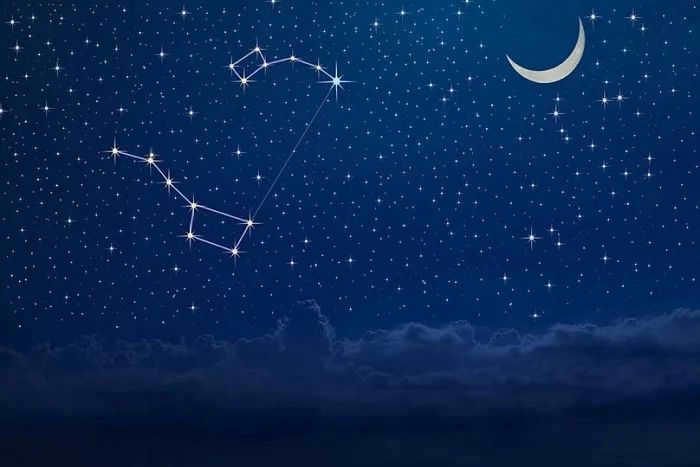
The Big Dipper and the Little Dipper
Back in ancient times, before the invention of the compass, travelers and navigators relied on familiar constellations to guide them on land and water at night. The concept of a constellation has evolved over time, but in ancient times, it provided a reliable method of orientation.


- classified by age – young and old;
- categorized by luminosity: bright and faint;
- grouped by size: giants, supergiants, and dwarfs;
- Visible to the naked eye: visible and invisible;
- distinguished by temperature: hot and cold;
- sorted by color: yellow, red, blue, white. The colors are determined by the star’s surface temperature.
Ancient star formations
Afterwards, researchers from various nations have contributed additional terms to this compilation. Several collections of stars that were formerly considered as separate entities are now incorporated within other groupings. By examining these ancient constellations, contemporary astronomers strive to gain insight into the lifestyle and beliefs of our predecessors.
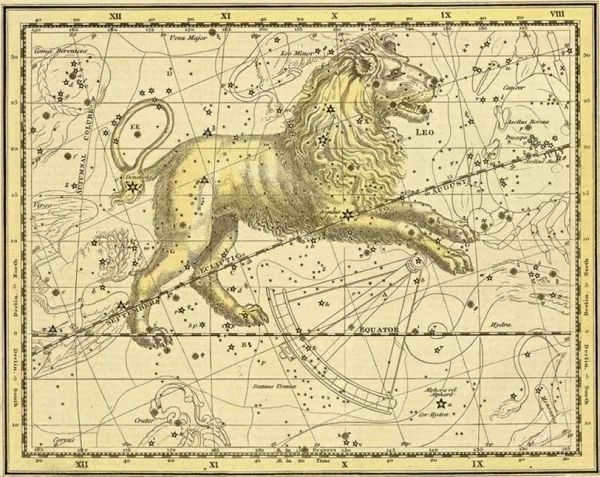
An ancient map showcases the Leo constellation
Modern constellations
How many constellations exist in the world? Astronomers today recognize 88 constellations. However, there were 117 constellations before the 19th century. The new count was established in 1922 at the International Conference of Astronomical Research. The International Astronomical Union (IAU) officially defined the boundaries of these constellations in 1935. Modern astronomers consider constellations as areas in the sky that contain various celestial objects.
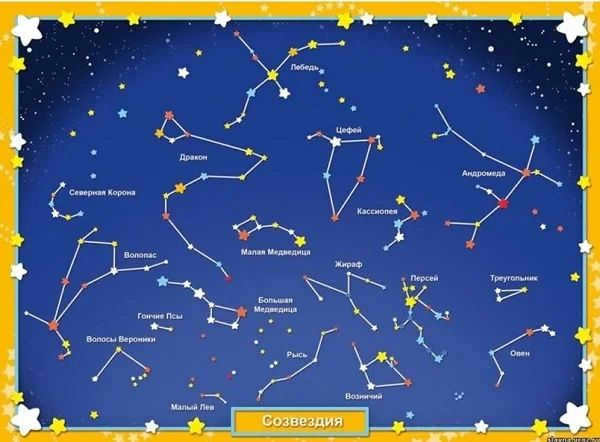
The best way to observe constellations and stars is to find a location with minimal light pollution and look up at a clear sky. When doing so, a mesmerizing view of the night sky will unfold before the observer, making it easy for anyone to locate the Big and Little Dipper constellations.
It is important to note that not all 88 celestial constellations can be seen from every country. In Russia, for example, only 54 constellations are visible.
One of the most stunning astral formations is undoubtedly the Orion constellation. Upon closer inspection, one can discern the distinct shape of a human figure within its cosmic arrangement.
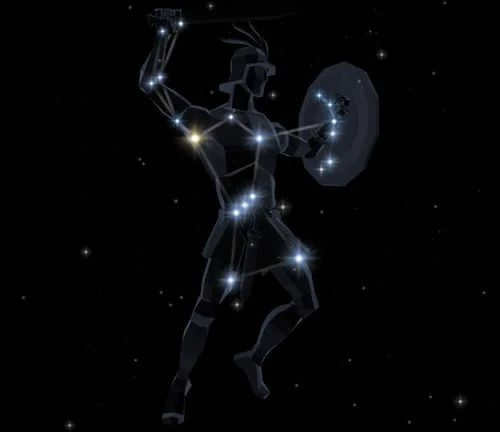
The name of the constellation Orion originated from ancient Greece. According to Greek mythology, Orion was a courageous and fearless hunter who met his demise from a scorpion’s sting. As a result, Zeus transformed him into a constellation that still illuminates the night sky. Orion can be observed throughout Russia and is easily identifiable by its seven prominent stars, which form the hunter’s body. What sets the constellation Orion apart is the presence of bright and hot stars. Each of these stars has its own unique name:
- Betelgeuse is a red-colored variable supergiant star and is considered one of the largest stars;
- Rigel is a system of three stars. It is composed of a brilliant white-blue supergiant star called Rigel A and two smaller satellites;
- Bellatrix is a giant star with a color that is blue-white;
- Saif is a blue supergiant;
- Alnitak, Alnilam, and Mintaka make up Orion’s belt. These stars are supergiants with a blue hue.
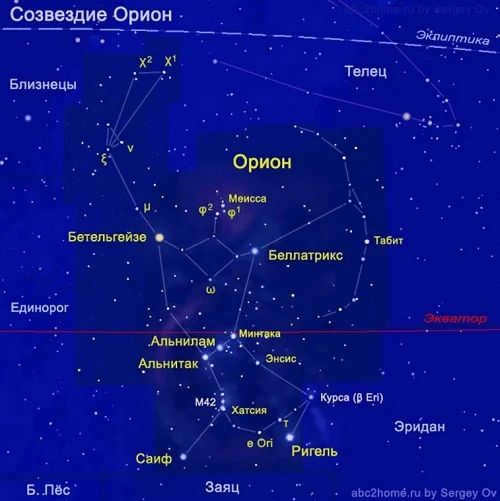
Source
The constellations in the night sky are composed of stars that are situated at varying distances from Earth. Some stars are closer to us, while others are farther away. The best time to observe the Orion constellation is during the autumn and winter months, and it can be found in the southern part of the sky.
The Swan constellation is equally stunning and captivating. It ranks as the 16th largest constellation in terms of size. This constellation is particularly visible during the summer months in the southeastern part of the sky. It is quite easy to spot a cross-shaped figure with bright stars in the sky.
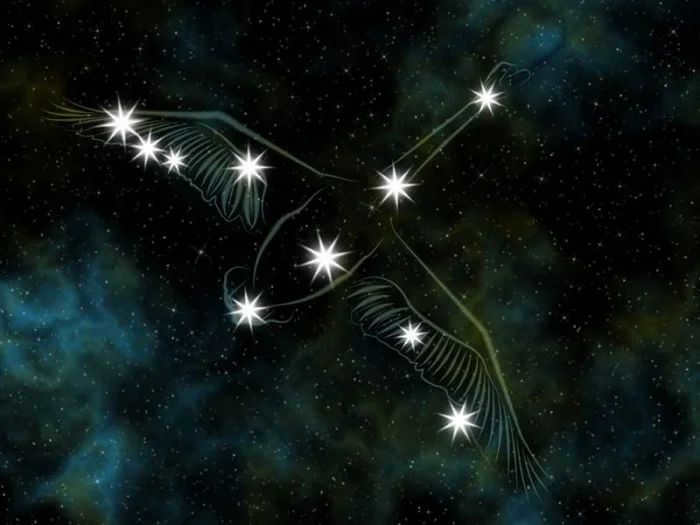
Located within the constellation of Cygnus, the stars in this constellation are truly remarkable:
- Deneb, the brightest star in the Cygnus constellation, shines at its apex. Not only is Deneb one of the largest and brightest stars in Cygnus, but it is also among the largest and brightest stars in the entire universe. To put it into perspective, Deneb is 240 times larger than our Sun. In just one day, Deneb emits as much light as our Sun does in 140 years.
- Sadr, the second brightest star in the universe, is another stunning celestial body within Cygnus.
- Jenach, a massive star with a beautiful orange hue, adds to the splendor of the Cygnus constellation.
- Albireo is a binary star system that is easily observable with a telescope. While it may appear as a single star to the naked eye, closer inspection reveals two nearby stars. Even those who have little interest in astronomy find Albireo fascinating due to its brightness and beauty. The system consists of an orange-colored giant star and a blue companion.
- Delta of the Swan, the third largest star in the constellation of the Swan, is said to replace Polaris after four centuries, according to prophecy. This three-star system is composed of two closely situated stars and a third star that is much more distant.
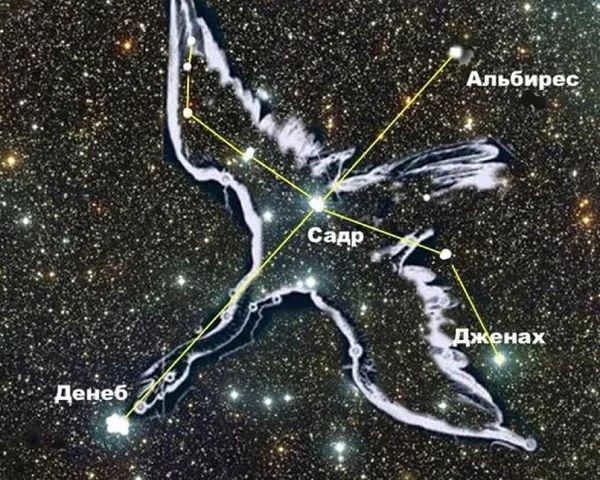
The Sun is a celestial body within the solar system
The Sun is the sole celestial body that is a part of the solar system. The existence of life on Earth is reliant on this cosmic luminary for a multitude of reasons. Its beams provide warmth to all living organisms, granting them the gift of life and joy. It takes a mere 8 minutes and 20 seconds for a sunbeam to reach the Earth’s surface. In addition to the Sun, the solar system is also comprised of other celestial entities that orbit around this particular star. These include comets, planets with moons, asteroids, meteoroids, and space debris.
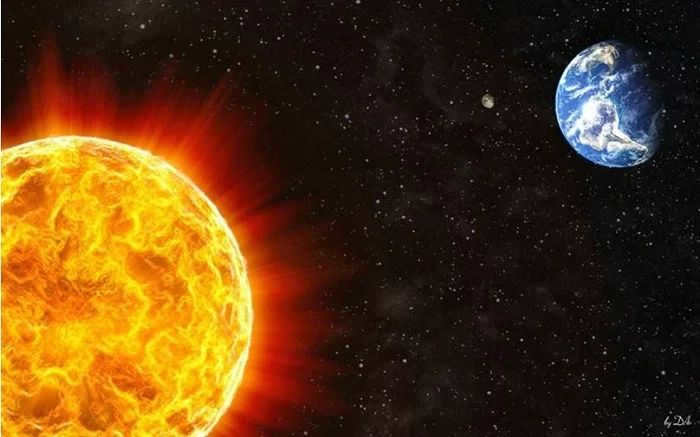
The sun and planet Earth
It is an interesting fact that the mass of the sun accounts for 99.8% of the total mass of the solar system. In terms of size, it is not as massive as it appears from Earth. There are stars that are much larger and brighter. The yellow color of the sun is also deceiving. In reality, the sun, with its high surface temperature of 6000K, emits light that is not yellow, as commonly believed, but rather almost white. It is only when sunlight reaches the Earth’s surface that it takes on a slightly yellowish hue. This is because the Earth’s atmosphere absorbs the shorter wavelengths of the spectrum, resulting in stronger scattering.


By examining the Sun’s chemical composition, it is composed of 73% hydrogen and 25% helium, making up the majority of its mass. The remaining 2% consists of various elements such as calcium, nitrogen, iron, oxygen, magnesium, sulfur, chromium, nickel, silicon, neon, and carbon.
At the core of the Sun lies a nucleus, with a radius of approximately 150,000 kilometers. Temperatures at the center can exceed fourteen million degrees.
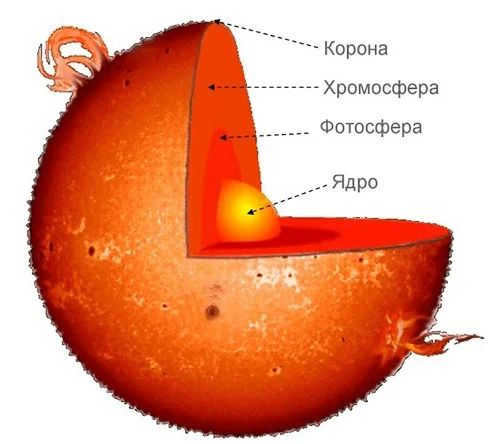
The composition of the Sun
The Sun possesses the most powerful magnetic field. Solar activity, which is caused by fluctuations in the magnetic field, contributes to the phenomenon of the aurora borealis and geomagnetic storms. However, these natural occurrences do not always have a positive impact on the well-being of individuals.
Astronomical scientists have provided evidence that the Sun has only completed half of its lifespan, which is projected to be at least ten billion years. The age of this celestial body was determined through the utilization of computer technology and is currently estimated to be approximately 4.57 billion years.
When people observe celestial objects, they can see that these objects appear to move across the sky and change their position throughout the day. This movement is actually caused by the Earth’s rotation, as it completes one full revolution on its axis every 24 hours. This phenomenon is not limited to just the stars in the nighttime sky, but also includes the Moon, the Sun, and the planets. In order to accurately describe the position of these objects in the sky, astronomers utilize a system of numbers known as celestial coordinates.
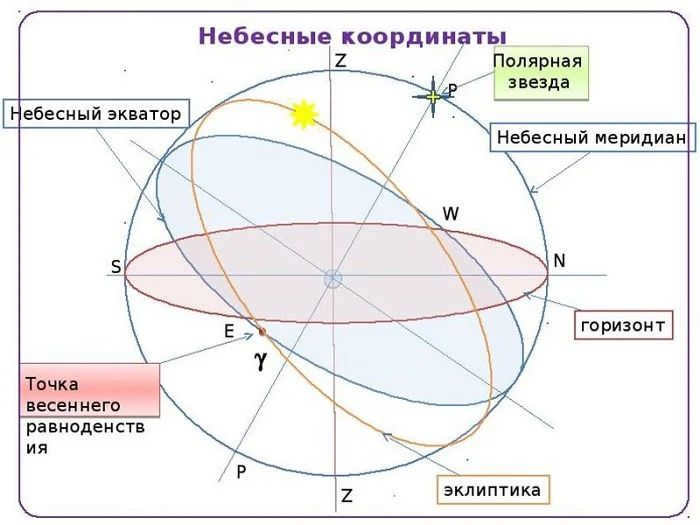
Source
The appearance of the sky when observed from Earth is similar to that of a sphere, which means that astronomical coordinates can be represented as spherical coordinates, resembling the arcs of circles on the surface of a sphere. These coordinates together form the celestial coordinate system.

There are several types of celestial coordinate systems in astronomy, each distinguished by their choice of main plane and point of reference. The specific system used depends on the tasks at hand for scientists. The horizontal and equatorial coordinate systems are commonly used for measurement purposes, while the ecliptic and galactic coordinate systems are used less frequently.
The horizontal coordinate system takes the horizon as its main plane and is used for observing celestial objects from the Earth’s surface. This can be done with or without a telescope, and the coordinates change due to the Earth’s daily rotation.
In the celestial coordinate system, a fixed reference point is selected that remains stationary relative to the stars and undergoes daily rotation. This reference point is known as the vernal equinox. There are two variations of the equatorial coordinate system, both of which utilize the celestial equator as the fundamental plane.
The ecliptic is a prominent circle in the sky that tracks the annual movement of the Sun (as observed from Earth) in relation to the surrounding stars.
Celestial equator
The concept of the celestial sphere is employed by astronomy to ascertain the apparent position and investigate the movement of a celestial object.

The celestial sphere is separated into the northern and southern hemispheres by the celestial equator. Equatorial constellations are those constellations that lie along the celestial equator.
Celestial meridian

The stars in the sky can be observed moving across the celestial sphere, which is divided into two hemispheres: the western and eastern hemispheres, by the celestial meridian.
Observing the motion of the stars
All celestial objects in the sky have a constant motion, although it may not be easily noticeable to the naked eye. When observing the stars, they may appear motionless, but this is a misconception. In comparison to the moon or the sun, the stars have a nearly imperceptible displacement. This is due to their relatively small speed combined with their vast distance from the Earth. To observe the movement of a star, a telescope is required as the naked eye cannot detect it, even with years of observation from the same location. It is interesting to note that the Sun and Bernard’s star, which cannot be seen without a telescope, have a rapid proper motion. Despite its invisibility to the naked eye, this star has a greater angular velocity compared to others.
The constellations divide the entire celestial sphere, and it was a tradition many centuries ago to link the stars seen from Earth with imaginary lines, creating whimsical figures that were then given names. Identifying these figures as animals or heroes after whom the constellations were named requires a highly developed imagination. In total, there are 88 constellations in the sky, with 54 of them being visible from Russia.
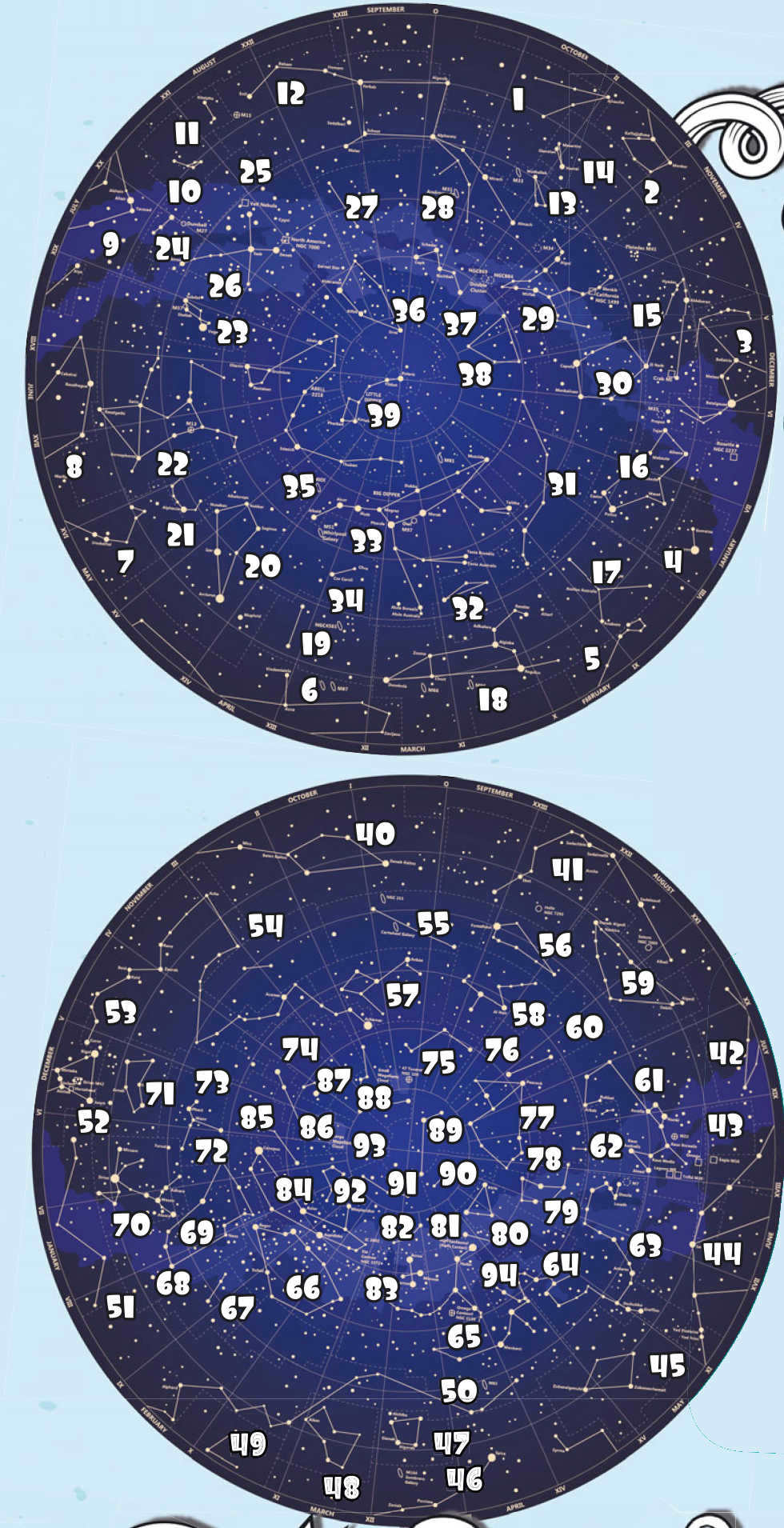
Constellations in the Northern Hemisphere
2. Whale (a portion of the constellation, with the other part located in the Southern Hemisphere).
8. Serpentine (a portion of the constellation).
Constellations in the Southern Hemisphere
44. Serpentine (a portion of the constellation).
The star chart created by Frederick de Wit in the 17th century showcases various constellations. Out of the total 88 constellations, 48 were initially identified by ancient scholars from the Hellenic world. These 48 constellations can be observed from regions in southern Europe and the Mediterranean. The remaining 40 constellations were discovered during the 17th and 18th centuries, when explorers ventured into the Southern Hemisphere due to the Great Geographical Discoveries. These constellations bear names that pay tribute to both real and mythical creatures (such as Scorpio and Capricorn), as well as legendary figures from ancient Greek myths (like Andromeda and Perseus). Additionally, some constellations are named after objects that resemble their shape, such as Triangle and Libra.
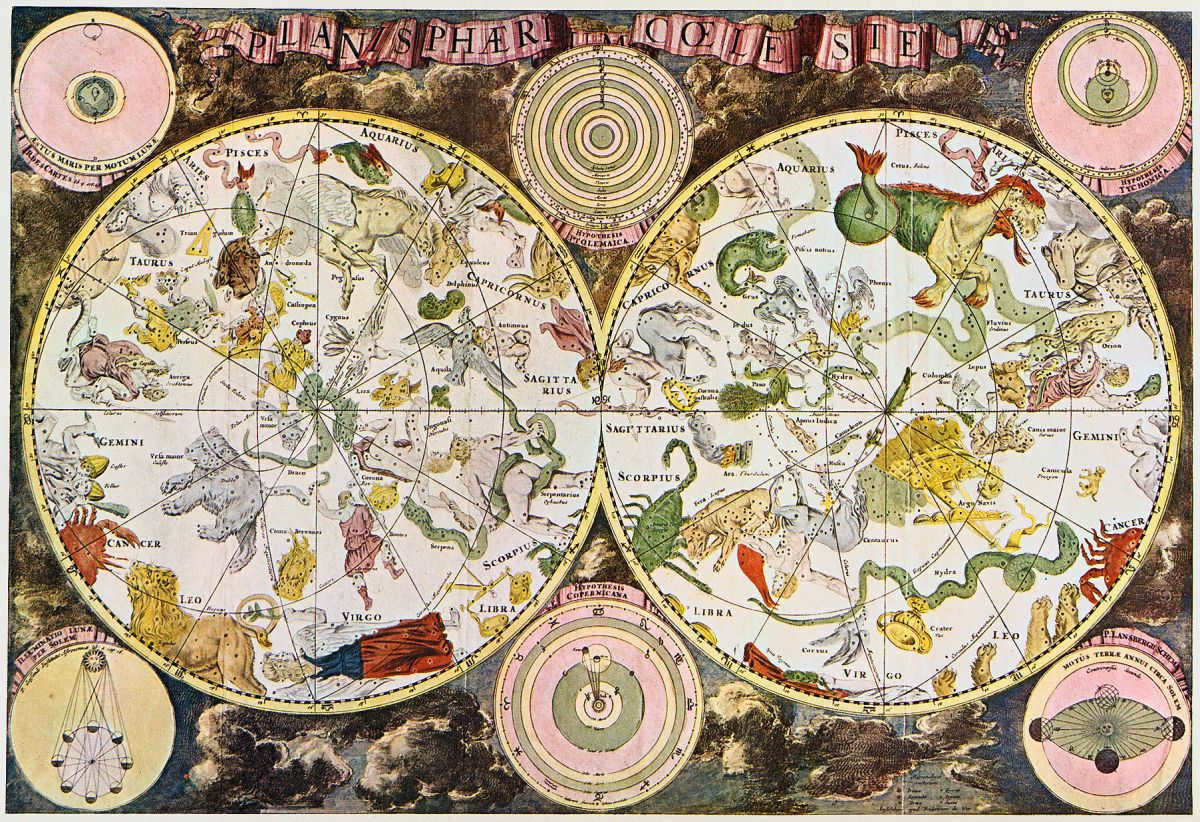
Star names
Ancient Greek, Latin, or Arabic names have been assigned to the most prominent stars. Centuries ago, astronomers devised a standardized system for naming stars using the Greek alphabet. The brightest star was designated alpha (the first letter of the Greek alphabet), the second brightest was designated beta (the second letter), and so on until omega (the final letter of the 24-letter Greek alphabet).
Fascinating constellations of the Southern Hemisphere
The constellation Hydra, which is located in the Southern Hemisphere, takes its name from a mythical creature in Greek mythology. This creature, known for its creepy and malevolent nature, had a serpent-like body and deadly breath, and was ultimately killed by the hero Hercules. There are also other constellations in the Southern Hemisphere, such as Raven and Sagittarius, which are smaller and not as “sinister.” These constellations contain some interesting celestial objects.
Stars and surroundings of the Hydra constellation
Hydra is the largest constellation in the entire celestial sphere. In the western part of the constellation, there is a polygon known as the “Hydra’s Head.” The “head” was referred to as the “Pearl Necklace” by Arab astronomers and as the “Scarlet Bird” by Chinese astronomers.
- Description: The Hydra constellation is located in the Southern Hemisphere.
- Area: It covers an area of 1303 square degrees.
- Number of stars: There are approximately 300 stars in the constellation.
- Brightest stars: The brightest stars in Hydra are Alfard and Gamma Hydra.
- Neighboring constellations: Hydra is neighbored by Virgo, Cup, Raven, Sextant, Leo, Cancer, Little Dog, Unicorn, Corma, Compass, Pump, Centaurus, Wolf, and Libra.
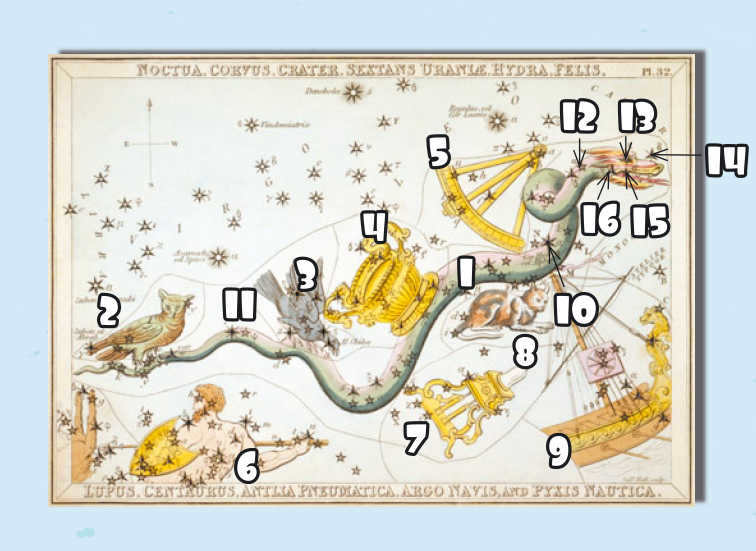
The constellation Hydra (1) can be seen in Alexander Jamieson’s 1824 Celestial Atlas, surrounded by the constellations Owl (2), Raven (3), Cup (4), Sextant (5), Centaurus (6), Pump (7), Cat (8), and Feed (9).
The brightest star in Hydra is called Alphard (10), and it is 40 times larger than our Sun. Hydra’s gamma (11) can be found in its tail. The group of stars known as “Hydra’s Head” consists of zeta (12), epsilon (13), delta (14), sigma (15), and eta (16), but none of them have been given individual names.
Galaxy of Antennas
In the year 1785, precisely 250 years ago, the renowned astronomer William Herschel made a remarkable discovery – an elongated cosmic nebula known as the Antenna Galaxy, located in the constellation Raven. Thanks to advancements in modern technology, it has been revealed that this nebula is, in fact, a pair of colliding spiral galaxies. Within their cores, a future unified galaxy is gradually taking shape.
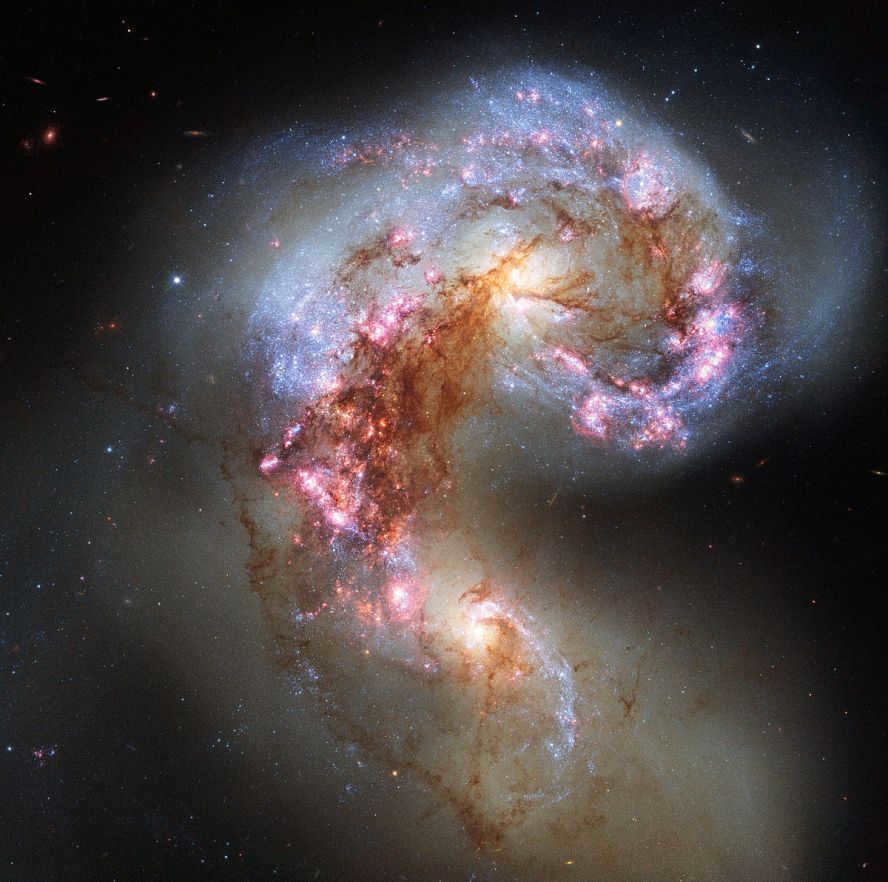
The Southern Spiral Galaxy
M83, also known as the Southern Spiral, is a stunning celestial object located in the constellation Hydra. It was initially identified by Nicola Lacaille, a French astronomer, back in 1752. Compared to our own Milky Way galaxy, the diameter of this spiral galaxy is relatively small, measuring around 40,000 light-years.

The constellations in Sagittarius
The center of the Milky Way galaxy is located in the constellation Sagittarius, which is approximately 30,000 light years away from us. The brightest star in Sagittarius is Alpha Sagittarius (17), also known as Rukbat Alrami, which means “archer’s knee” in Arabic. Beta Sagittarius (18) is called Arqab Prior, which translates to “tendon of the ankle”. Gamma Sagittarius (19) is known as Alnasl, meaning “arrowhead”. Delta Sagittarius (20) is named Kaus Medius, which signifies the “middle of the bow”. Epsilon Sagittarius (21) is called Kaus Australis, indicating the “southern part of the bow”. And finally, lambda Sagittarius (22) is known as Kaus Borealis, representing the “northern part of the bow”.
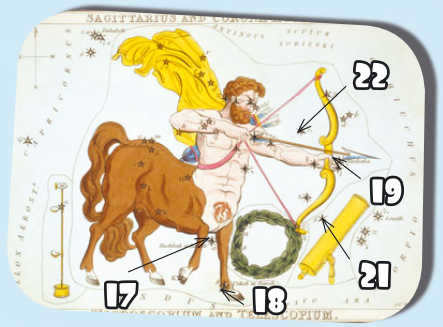
The Triple Nebula: A Colorful Spectacle
One of the remarkable celestial wonders found in the Orion constellation is the Triple Nebula. Named by William Herschel, this nebula resembles three petals intertwined together. The Triple Nebula showcases dark dust fibers that were created within the atmospheres of massive cold stars. It spans an impressive distance of -50 light-years and is situated 2000-9000 light-years away from the Sun.
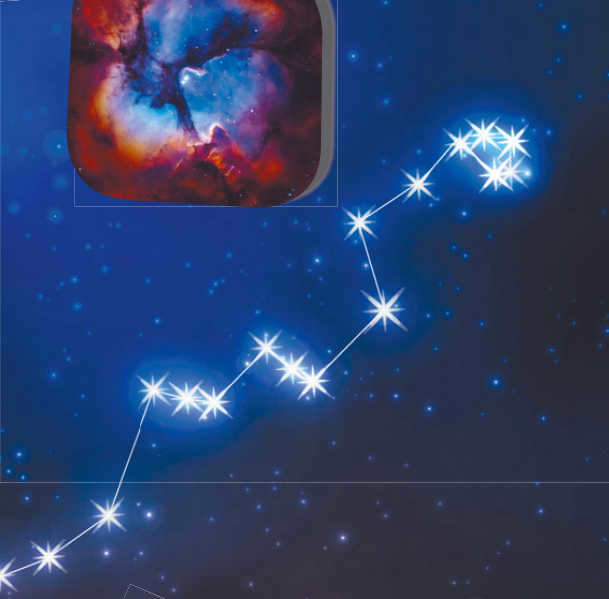
The Lagoon Nebula
During the summer months, the Lagoon Nebula offers a breathtaking spectacle that can be observed even without the aid of a telescope. Situated in the constellation of Sagittarius, this massive cloud formation is known for its vibrant colors and intricate details. The Lagoon Nebula resembles a vast body of water, with a dark cluster resembling a bay and surrounding land that appears to be bathed in the warm glow of a coastal city’s lights.
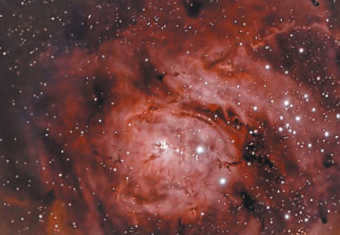
Fascinating star patterns in the Northern Hemisphere
Above the North Pole of our planet lie three captivating star patterns: Ursa Minor, Ursa Major, and Draco. According to ancient Greek legends, Ursa Major represents the beautiful maiden Callisto, who was transformed into a bear due to jealousy from the goddess Hera. Ursa Minor, on the other hand, represents Arcas, Callisto’s son, who was transformed into a young bear by the god Zeus. Eventually, this celestial family was reunited forever as constellations in the night sky.
The Big Dipper is the third largest constellation, following Hydra and Virgo. It is often referred to as “the tail” of the bear, and its four adjacent stars create a shape that resembles a bucket with a handle. This constellation is highly visible in our sky and stands out prominently.
- Description: The Big Dipper is a constellation located in the Northern Hemisphere.
- Area: It covers an area of 1,280 square degrees.
- Number of stars: There are over 200 stars in the Big Dipper.
- Brightest stars: Some of the brightest stars in this constellation include Dubhe, Merak, Fekda, Megretz, Aliot, Mitsar, and Benetnash.
- Neighboring constellations: The Big Dipper is surrounded by Giraffe, Lynx, Lesser Lion, Lion, Veronica’s Hair, Hound Dogs, and Volopa.
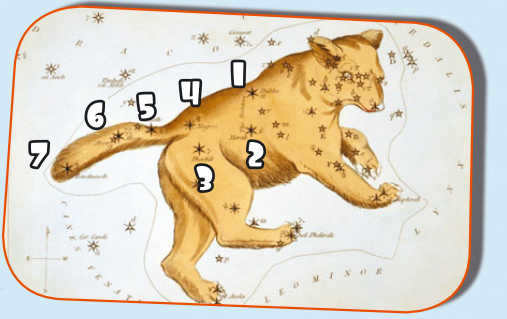
The constellation in the sky known as the Big Dipper consists of seven bright stars that are arranged in the shape of a large bucket. Dubhe, the first star in the constellation, is referred to as the “back of the big bear.” Merak, the second star, represents the “loins,” while Feqda, the third star, symbolizes the “thigh.” The fourth star, Megretz, is called the “beginning of the tail,” and the fifth star, Aliot, is known as the “mound.” Mizar, the sixth star, is referred to as the “girdle,” and Benetnash, or Alkaid, the seventh star, is considered the “leader of the mourners.”
The celebrities of the Little Bear and the Dragon
The Little Bear is a compact constellation located in the Northern Hemisphere of the celestial sphere. It comprises a total of 25 stars, out of which the 7 most prominent ones form a group known as the Small Bucket: Polaris (alpha) (8), Kohab (beta) – “celestial body” (9), Ferkad (gamma) (10) – “calf”, Yildun (delta) (11) – “star”, as well as Urodelus (epsilon) (12) – “tail of the bear”, Ahfa al Farqadain (zeta) (13) – “pair of calves”, and Anwar al Farqadain (eta) (14) – “the brightest of the two calves”.
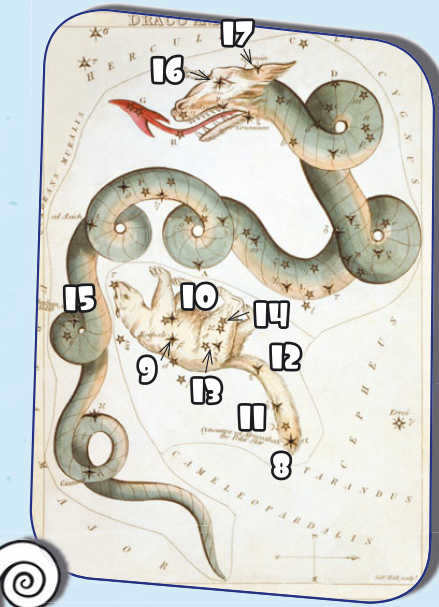
The Dragon constellation, which is the eighth largest, appears to coil itself around the North Pole and the Little Bear. The alpha star of the Dragon is Tuban (15), which translates from Arabic as “snake.” The Dragon’s Head, also known as the Rhombus, is made up of the stars Rastaban (beta) (16) – the “head of the snake” and Etamin (17) (gamma) – the “dragon.”
The primary star in the northern hemisphere
Polaris (18), also known as the “end of the tail” of Ursa Minor, can be found near the North Pole. It is extremely useful for navigation purposes: it remains relatively stationary throughout the day and serves as a reliable indicator of the north. By drawing a direct line between the stars Merak (19) and Dubhe (20), which are part of the “wall” of the Big Dipper, one can easily locate Polaris.
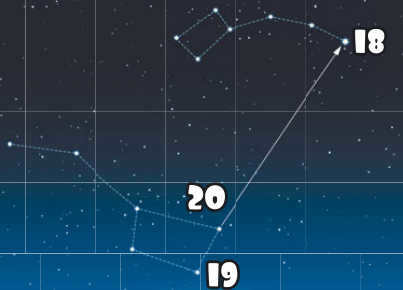
The initial “metallic.”
The exoplanet Kepler-10b (21) revolves around the star Kepler-10 in the Draco constellation. This celestial body is approximately 1.4 times bigger than our own planet (22) and has a mass 4.6 times greater. It holds the distinction of being the very first known planet primarily made up of iron. On its daylight side, the temperature on the surface goes beyond 1500 °C, causing the iron to exist in a liquefied state.
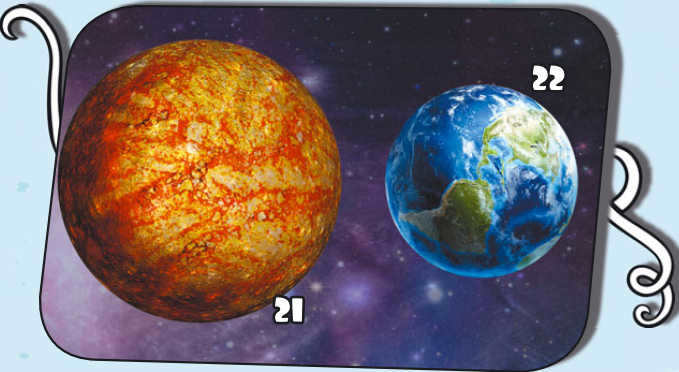
The Nebula Known as the Cat’s Eye
In the constellation Draco, there used to exist a brilliant and hot star at the heart of what is now known as the Cat’s Eye Nebula. However, approximately a millennium ago, this star shed its outer shell, resulting in the formation of the nebula. The central star of this nebula shines 10,000 times brighter than the Sun, while measuring a radius of 0.65 times that of our own solar radius.
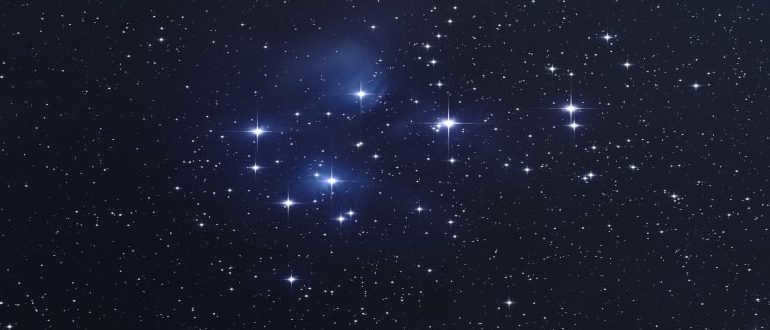
Stars and constellations have captivated humanity for countless centuries. From the moment Australopithecus transformed into an intelligent species, individuals have been captivated by the radiant specks that adorn the sky. Over time, these specks were named stars, and people discovered how to arrange them into constellations.
What is a constellation?
A constellation refers to a group of closely spaced stars in the sky. Over time, humans have used their imagination to associate these celestial systems with familiar objects and creatures, giving them unique names. However, in 1930, a significant number of previously recognized constellations were removed from the modern MAC (International Astronomical Union) standard. This decision came about because, throughout history, travelers, navigators, and ancient astronomers often defined the boundaries and assigned names to new constellations based on personal preference and discretion. Occasionally, these boundaries would overlap with existing constellations, leading to the cancellation of some.
The classification of stars into northern and southern groups is based on their visibility from specific hemispheres on Earth. The northern group comprises of 36 star clusters, while the southern group consists of 52 clusters. These clusters vary in size, with some being small like the Hound Dogs, and others being large and composed of numerous suns like Hercules. However, only 140 stars within these clusters can be observed with the naked eye. While some of these stars can be seen from Russia, others require a trip to Africa for viewing. Additionally, certain stars in these groups can be observed throughout the year, while others are only visible seasonally. These variations in visibility are due to the positions of the stars in relation to the Earth’s poles and the orbital motion of our planet.
There are a total of 52 constellations in the southern part of the sky, and it would be impractical to list them all here. Some of the well-known constellations include Orion, Scorpius, and Swan, while others may only be familiar to specialists, such as Fly, Indian, and Raven.
Spring
In the northern hemisphere, during spring, you can observe:
- The constellations Sails, Keel, and Stern Ascendant, as well as Andromeda and Cassiopeia;
- The constellations Hydra, Perseus, Lynx, Cup, and Hound Dogs.
- The Fly and the Raven; Gemini, Centaurus, and the Magus; Compass, Southern Cross, the Lesser Dog, and the Lion; the Flying Fish and the Pump.
Therefore, in the northern hemisphere, people can observe a total of 12 constellations during spring, while in the southern hemisphere, there are 13 constellations. The Great Bear, Virgo, and Sextant can be seen from all parts of the world.
During the summer nights in the northern hemisphere, you can observe various constellations including:
On the opposite side of the sky, you can see the following constellations:
- Circulus, Sacrifice, and Wolf; Naugol, Serpent, and Scorpio;
- Shield, Serpent, Telescope, Sagittarius, and the Southern Triangle and Crown.
Overall, people in the northern hemisphere can see a total of 5 star systems, while those in the southern hemisphere can see 12 star systems, in addition to the commonly visible ones like Libra and the Little Bear.
Autumn
The fall sky in the north is adorned:
Southern hemisphere dwellers can observe:
- Capricornus, Grus, and Piscis Austrinus;
- Indus, Octans, Cygnus, Phoenix, and Pavo, as well as Aquarius and Microscopium.
Therefore, there are 7 constellations visible to people in the north, and 9 to those in the south.
Winter
The constellations visible in the winter season in the northern hemisphere include Orion, Perseus, Taurus, and Aries.
These constellations can be observed in the southern sky during the winter months:
While 4 constellations are visible in the northern hemisphere, those in the antipodes can observe 9 star clusters.
Zodiacal constellations – what are they?
The distinguishing feature of Zodiacal constellations is that they lie along the ecliptic, the path of the Earth’s orbit around the Sun. Apart from this, they are similar to other constellations, and astrologers attribute mystical properties to them.
- Aries;
- Taurus;
- Gemini;
- Cancer;
- Leo;
- Virgo;
- Libra;
- Scorpio;
- Sagittarius;
- Capricorn;
- Aquarius;
- Pisces.
Observing the Night Sky
Observing the night sky can be done in various ways – through a powerful telescope, with a pair of binoculars, or even just with the naked eye. Regardless of the method, the basic concept remains the same. During a span of several hours, one can observe the smooth movement of the celestial sphere from left to right, known as diurnal motion. Every cosmic object becomes visible in the eastern part of the sky and disappears in the west, with only the exact points of rising and setting changing based on the season. For instance, consistent observation will reveal that during winter, the Sun rises in the southeast and sets in the southwest, albeit with a gradual shift in the points of rising and setting.
Scientific observations have provided evidence that celestial bodies are not stationary. They are in constant motion around our planet, appearing to the naked eye as if they are moving, but in reality, it is the Earth, the Moon, the planets and their satellites, and even the entire universe that are making circular movements. The Moon, for instance, moves in an eastward direction, shifting approximately 13 degrees within a span of 24 hours. It completes a full orbit around the Earth in 27.32 Earth days, passing through the well-known systems of the Zodiacal circle during this time. On the other hand, the Sun takes 365 Earth days to complete its orbit.
The Assembly of the International Astronomical Union established clear boundaries for celestial systems in 1922, and finalized them in 1936. Astronomer Henry Russell proposed the idea of defining individual boundaries for each system, and his suggestion was adopted. Later, in 1930, E. Delport made further improvements to the map by adding vertical and horizontal lines, similar to Earth’s latitude and longitude. These additions helped to make the boundaries of star clusters more precise and easier to understand. However, it is important to remember that concepts of space are relative to Earth. The boundaries on the celestial map are conditional due to the three-dimensional nature of space and the vast distances involved. This means that an object visible today may no longer exist by the time its light reaches us, as it may have taken billions of years to reach Earth from distant galaxies.
The official catalogue comprises 88 constellations acknowledged by the MAC. Scientists do not deem it necessary to expand the current list, as the cosmos is continuously scrutinized and documented. While the new classification would undoubtedly be intricate, it would also be redundant. Established stars serve as guiding lights and reference points, rendering the inclusion of clusters situated at astronomically distant distances illogical. It is likely that the list will be updated as new celestial bodies emerge, considering that in terms of space-time measurements, it is practically infinite for humanity.
The term “asterism” is used to describe a distinct and prominent group of stars that has a historical association. This concept encompasses star clusters that are named after objects or shapes such as a cross, bucket, triangle, or square.
Some characteristics that correspond to asterisms include:
- Their names have historical origins.
- They are visible to the naked eye.
- They have a recognizable shape and consist of a limited number of celestial objects.
- Parts of one asterism may be located in different constellations.
An excellent example of an asterism is the Bucket of the Great Bear.
In the past, these concepts were considered to have the same meaning. The scientific distinction was made in the late 1930s.
- Asterisms, unlike systems, do not have clear boundaries.
- An asterism is made up of only the brightest stars.
- Each asterism can be seen with the naked eye, while not all clusters can be observed with a regular telescope.
Throughout history, asterisms have served as a navigational tool for seafarers and travelers, especially in times when compasses and navigators were not yet available and the astrolabe had not yet been invented.
Names are influenced by the time period in which they were discovered – either in ancient times or more recently. In ancient times, the names of open systems were closely tied to mythology. This is because religion and superstition played a major role in the lives of people, and the sky was believed to be the dwelling place of the gods. Each cluster was associated with the names of gods and mythical creatures, and legends were created around them. Some examples include Cassiopeia, Orion, Hercules, and others. In more recent times, nearby discoveries have been given names based on birds, animals, and even instruments. Some examples of these modern names are Circulus, Microscope, Compass, Raven, and Toucan.
In the portion of the sky that can be seen with the naked eye, there are over three thousand stars that can be observed, while the entire celestial sphere contains approximately 6,000 visible stars. Dimmer stars can be identified by directing our attention towards their brighter counterparts. The sky hosts a collection of prominent celestial bodies that are easily discernible:
These stars are strategically positioned in different regions according to the star chart.
Specialists in the field are the only ones who can truly understand all systems. However, there are some celestial bodies that have become widely recognized, even among those who have no interest in astronomy. These celestial bodies have had a significant impact on popular culture, with their names being used by companies, referenced in horoscopes, and even featured in movies and books.
- We have the famous constellations of Ursa Major and Ursa Minor, commonly known as the Big and Little Bears.
- Then there’s the brightest star after the Sun, which belongs to the constellation Canis Major and is often referred to as the Dog Star.
- Other well-known celestial bodies include Proxima Centauri, Virgo, Veronica’s Hair, Orion, Aquarius, Scorpio, Pisces, Leo, and all the other zodiac signs.
Regardless of one’s interest in astronomy, these names have become widely recognized by everyone.
Star clusters, located at such great distances from Earth, appear to be stationary. However, when observing the motion of nearby objects in relation to distant constellations, their movement becomes apparent. This backdrop provides an opportunity to calculate the trajectory, time, and angle of displacement. In the span of 27 days, the Moon completes a full revolution, passing through 12 areas of zodiacal signs and shifting by 13 degrees.
The MAC list now contains a total of 88 different constellations. These constellations are arranged in alphabetical order, starting with Andromeda and ending with the Lizard. The special table not only includes the names of the constellations but also other relevant information.
Here is the list of constellations:
- A – Andromeda;
- B – Gemini, the Big Dipper, the Big Dog;
- C – Libra, Aquarius, Ascendant, Wolf, Wolves, Magpie, Veronica’s Hair, Raven;
- D – Hercules, Hydra, Dove, Hound Dogs;
- E – Virgo, Dolphin, Dragon;
- F – Unicorn;
- G – Sacrifice, Painter, Giraffe, Crane;
- H – Hare, Serpent, Snake, Goldfish;
- I – Indian;
- L Swan, Lion, Flying Fish, Lyre, Foxy;
- M Little Bear, Little Horse, Little Lion, Little Dog, Microscope, Fly;
- N Pump, Naugolnik;
- O Aries, Octant, Eagle, Orion;
- P Peacock, Sails, Pegasus, Perseus, Furnace;
- R Bird of Paradise, Cancer, Chisel, Pisces, Lynx;
- S Northern Crown, Sextant, Grid, Scorpio, Sculptor, Table Mountain, Arrow, Sagittarius;
- T Telescope, Taurus, Triangle, Toucan;
- F Phoenix;
- X Chameleon;
- C Centaurus, Cepheus, Circulus;
- CH Clock, Cup;
- E Eridanus;
- Y Southern Hydra, Southern Crown, Southern Fish, Southern Cross, Southern Triangle;
- I Lizard;
Interesting facts
There are numerous fascinating pieces of information and facts regarding stars and entire systems. The list of these facts can be endless.
Here are just a few examples:
- Every star cluster exhibits motion – they change their position, but due to the long duration of this process, they appear stationary to humans;
- Not all stars are the same – some distant celestial sparks are actually galaxies, and this can be observed in images captured by the Hubble Space Telescope;
- In the northern hemisphere, Polaris of the Little Bear serves as a navigational point, while in the southern hemisphere, it is the Southern Cross;
- The Southern Cross, which is the smallest cluster, is composed of merely four stars.
Orion is regarded as the most stunning constellation in the starry sky due to its incredibly luminous stars. However, the sky itself is adorned with countless sparkling points, creating an infinitely beautiful spectacle, even if one is unfamiliar with any constellations.
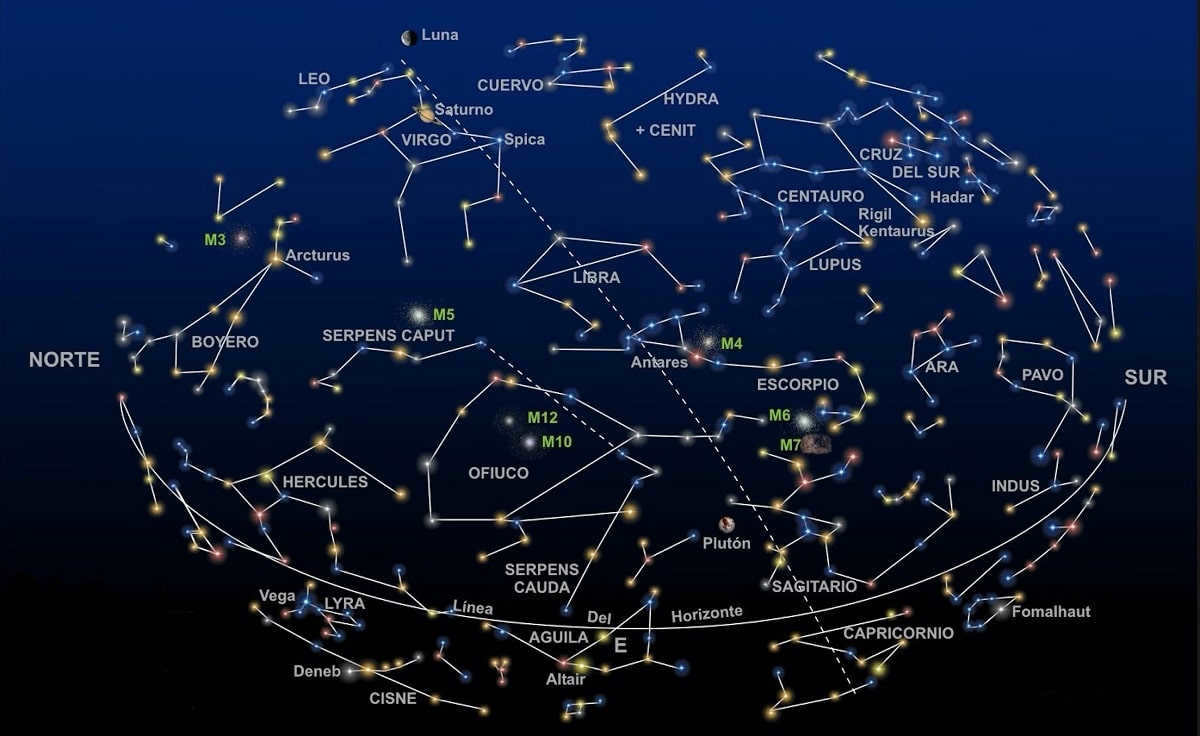
A total of eighty-eight constellations are officially recognized by the International Astronomical Union. These are groups of stars that create distinct, recognizable shapes. They do not overlap, and each has a unique designation. However, there are certain popular constellations that are widely known and easily identifiable in the night sky.
In this article, we will provide information on several renowned constellations, including their features and more.
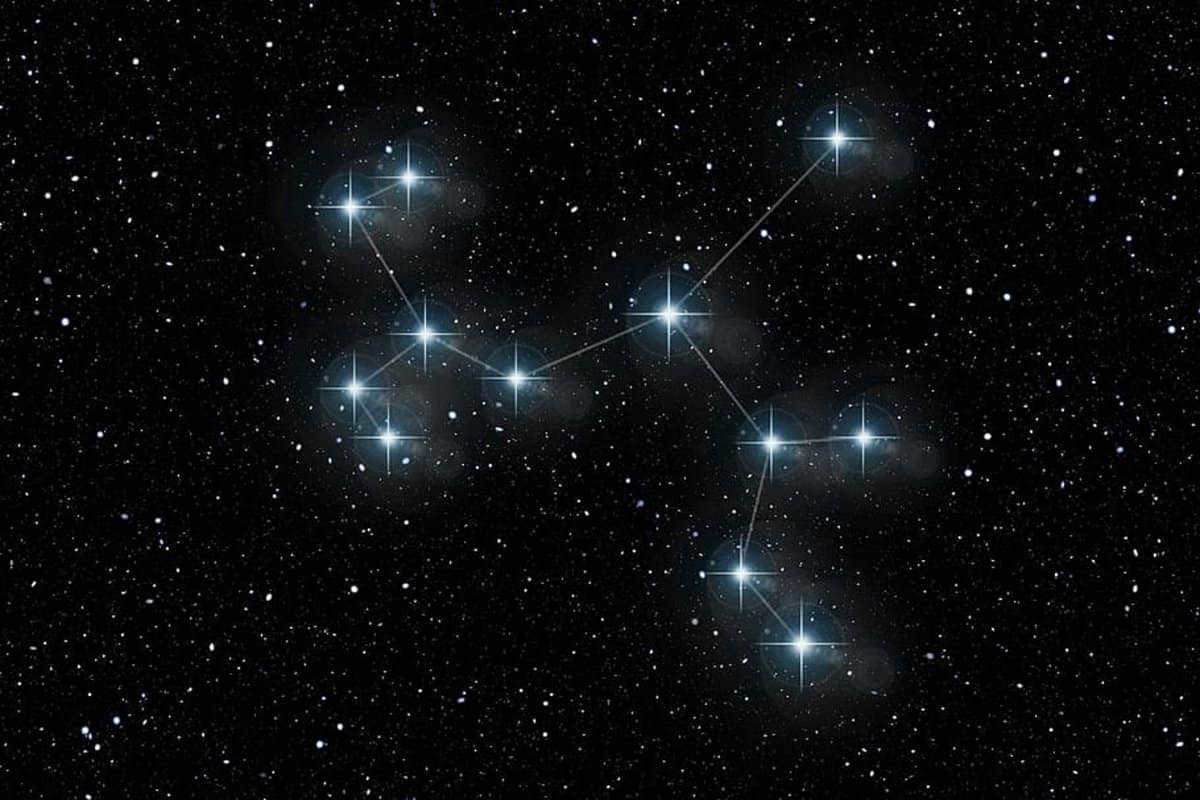
Back in the ancient times, astronomers devised constellations with no set system, resulting in a chaotic mess on astronomical maps where stars overlapped multiple constellations. With over a hundred constellations, there was no order to classify them.
In an effort to bring order, the International Astronomical Union convened its inaugural meeting in 1922 to establish a standardized classification for constellations. As a result, the list of constellations was trimmed down to eighty-eight, each assigned a distinct name.
However, in 1925, another meeting was held to delineate the boundaries between these constellations. This led to the creation of the map of the night sky that we are familiar with today, depicting eighty-eight constellations with clearly defined borders.
Renowned star formations
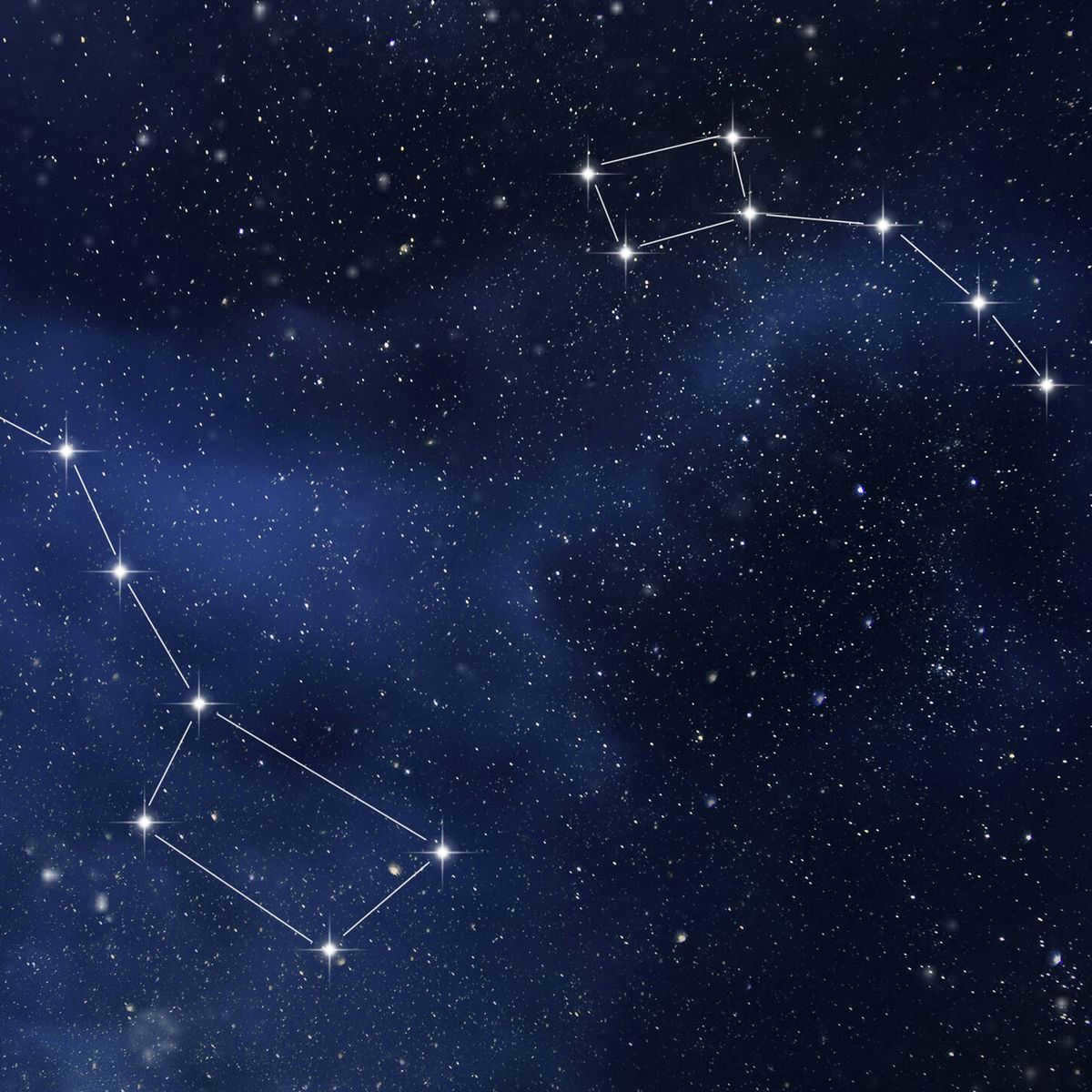
Ursa Major
The Ursa Major is a famous and easily identifiable constellation in the nighttime sky. It consists of seven prominent stars that create a shape resembling a pail or wagon, depending on one’s perspective.
One of the remarkable aspects of the Ursa Major is its usefulness in locating other constellations and celestial objects. For instance, one can locate Polaris, which serves as the marker for the celestial north.
Another notable characteristic of this constellation is that it is a circumpolar constellation, meaning it is always visible in the nighttime sky from most latitudes in the northern hemisphere. This is due to its proximity to the North Celestial Pole, and its movement across the sky is gradual enough that it never completely vanishes beyond the horizon.
The Small Bear
The Small Bear is another group of stars that can be easily identified in the night sky. Similar to the Big Dipper, it is a constellation near the North Pole in the Northern Hemisphere, making it visible from most latitudes. The Small Bear is made up of seven stars, with Polaris being the brightest and most well-known among them.
Polaris is located at the end of the tail and holds great significance for celestial navigation as it remains fixed in the sky, indicating the direction of the celestial north.
Cassiopeia
The constellation Cassiopeia is easily identifiable in the night sky due to its distinctive “M” or “W” shape. It can be observed near the North Celestial Pole, making it visible in the Northern Hemisphere throughout the year.
It is situated between the constellations Perseus and Cepheus. and its configuration is quite remarkable. This constellation is composed of five prominent stars that symbolize Queen Cassiopeia and her throne. The most brilliant star in Cassiopeia is known as Alpha Cassiopeia.
Large Canine
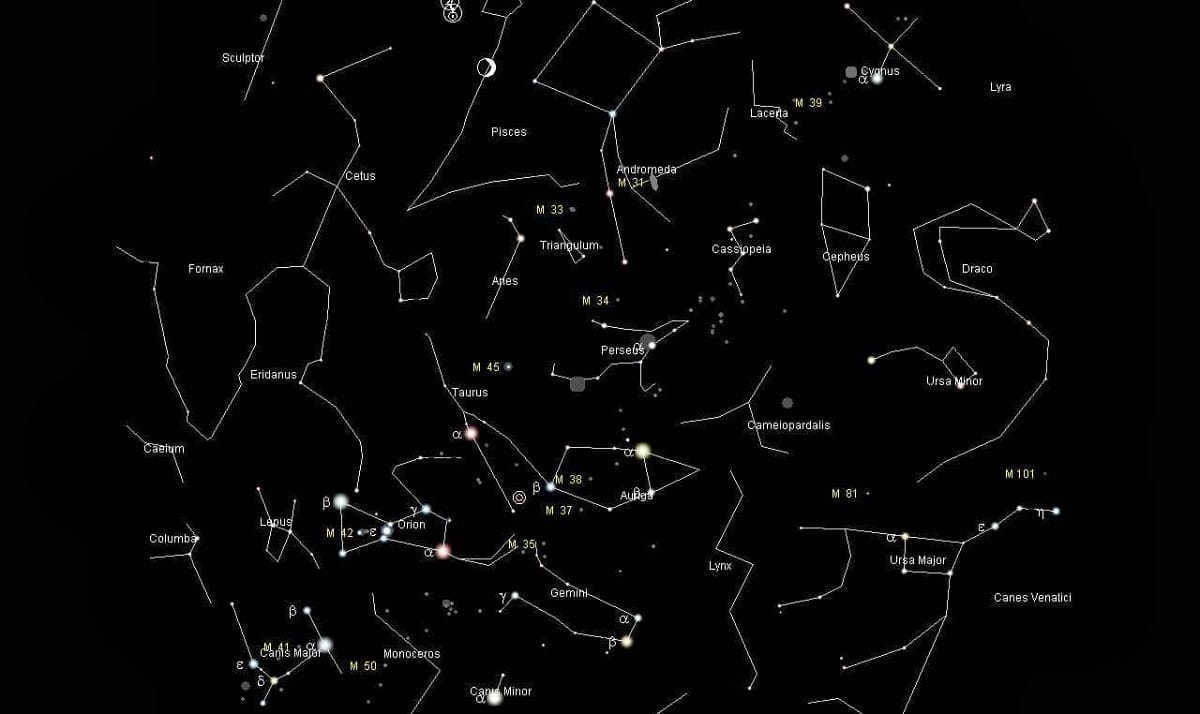
The constellation known as Canis Major can be observed in the nighttime sky of the southern hemisphere and is renowned for being one of the most brilliant and easily recognizable constellations. Its name originates from the Latin phrase “big dog,” and its most luminous star is Sirius, which holds the distinction of being the brightest star in the entire night sky. According to Greek mythology, Canis Major represents the loyal watchdog of the hunter Orion, who is also a neighboring constellation.
The stars within Canis Major collectively form the shape of a dog. Notably, this constellation contains a variety of nebulae and star clusters, which are clusters of stars situated in the same region of space. One of the most famous clusters within Canis Major is the M41 scattered cluster, which can be observed using small telescopes and binoculars.
The constellation known as the Northern Cross is situated in the northern hemisphere and possesses a distinctive shape resembling a cross. To differentiate it from its counterpart in the southern hemisphere, it is occasionally referred to as the “Little Cross.”
Comprised of four luminous stars arranged in the form of a cross, the most brilliant star within this celestial pattern is Polaris, also known as the North Star, located at the culmination of the cross. Aside from its cruciform configuration, this constellation can also be identified by its placement in the celestial sphere. It can be observed adjacent to the Big Dipper constellation and remains visible throughout the year in the Northern Hemisphere.
Finally, among the constellations that are widely recognized, we also find all of the zodiacal constellations, including Aries, Taurus, Gemini, Cancer, Leo, Virgo, Libra, Scorpio, Sagittarius, Capricorn, Aquarius, and Pisces.
By familiarizing yourself with this information, you will be able to gain a deeper understanding of these well-known constellations and their unique characteristics.
This article adheres to our stringent editorial guidelines to ensure accuracy and reliability. If you notice any errors, please click here to report them.
Summary of the full article: Network Meteorology " astronomy " constellations that are widely recognized

Once upon a time, a group of bright stars formed what is now known as a constellation. However, in the present day, constellations serve as areas for navigation and orientation in the sky.
Zodiac constellations
In ancient times, people were able to identify zodiac constellations in the sky. It was believed that the Sun passed through these constellations during its annual journey along the ecliptic. Interestingly, the ecliptic is divided into twelve equal parts, yet there are actually thirteen constellations.
Each constellation used to be associated with an animal name, which we are all familiar with. Furthermore, since ancient times, people have believed in the zodiac signs, which are connected to being born under a specific combination of stars.
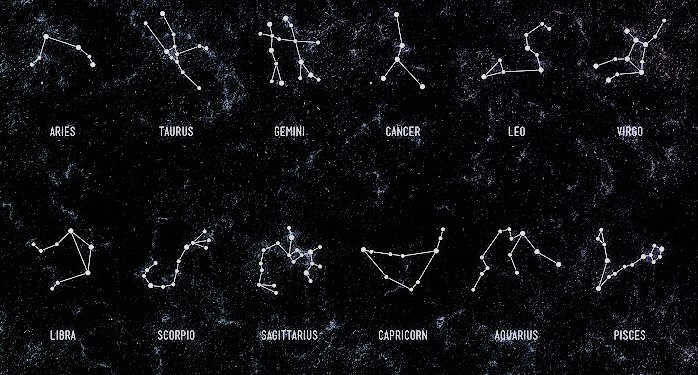
Allow us to refresh your memory on the zodiacal constellations that grace the night sky: Aries, Taurus, Gemini, Cancer, Leo, Virgo, Libra, Scorpio, Serpentor, Sagittarius, Capricorn, Aquarius, and Pisces.
Perhaps you are wondering about the nature of the Serpentor. It is indeed a fascinating question. However, it pertains to the constellations. You may have observed that it is named after a creature. The truth is, in traditional European astrology, it is not taken into consideration. As we now know, the zodiacal constellations do not precisely align with the zodiac signs. This discrepancy is a result of the Sun’s shifting motion.
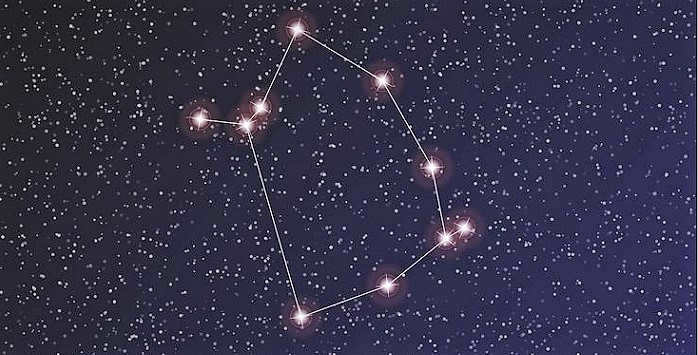
From November 30 to December 17, the Sun resides in the Serpentine constellation. It is worth noting that this group of stars is visible in Russia as well.
Undoubtedly, modern understanding of celestial structure differs from that of ancient times. However, in antiquity and later with the aid of telescopes, astronomers discovered exceptionally luminous stars within numerous constellations.
In modern astronomy, the concept of constellations as a collection of stars has become obsolete. This is due to the fact that the shapes formed by stars no longer provide a comprehensive representation of the night sky. Additionally, it has been discovered that certain stars can be part of multiple constellations simultaneously.
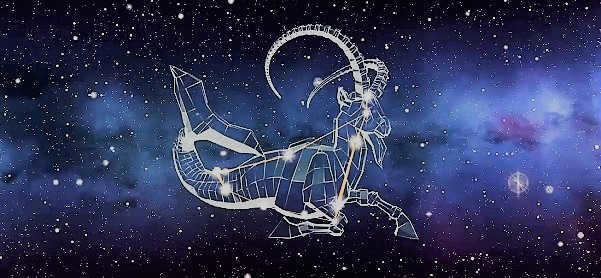
Currently, stars and constellations play a significant role in the field of modern astronomy. Constellations are defined as specific regions of the sky that divide it into distinct sections, allowing for easier navigation and comprehension of celestial space.
Furthermore, through the diligent study and research of the cosmos, more precise information has been acquired. As a result, 88 constellations have been identified and officially acknowledged. Additionally, scientists have been able to provide detailed descriptions for the majority of these constellations. Undoubtedly, this wealth of information is both crucial and enlightening.






